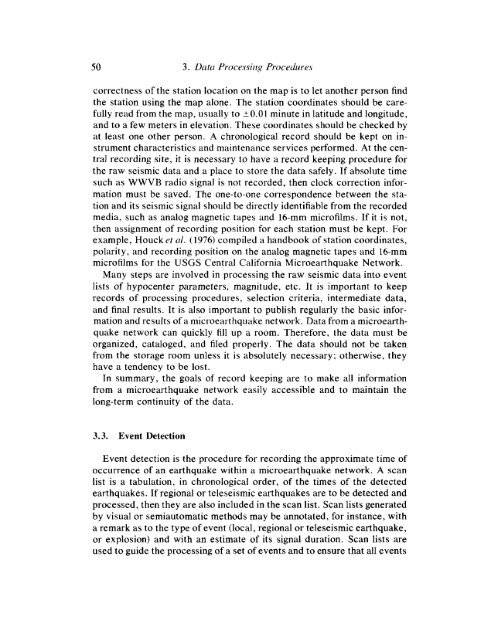principles and applications of microearthquake networks
principles and applications of microearthquake networks
principles and applications of microearthquake networks
Create successful ePaper yourself
Turn your PDF publications into a flip-book with our unique Google optimized e-Paper software.
50 3. Data Processitig Procedures<br />
correctness <strong>of</strong> the station location on the map is to let another person find<br />
the station using the map alone. The station coordinates should be carefully<br />
read from the map, usually to kO.01 minute in latitude <strong>and</strong> longitude,<br />
<strong>and</strong> to a few meters in elevation. These coordinates should be checked by<br />
at least one other person. A chronological record should be kept on instrument<br />
characteristics <strong>and</strong> maintenance services performed. At the central<br />
recording site, it is necessary to have a record keeping procedure for<br />
the raw seismic data <strong>and</strong> a place to store the data safely. If absolute time<br />
such as WWVB radio signal is not recorded, then clock correction information<br />
must be saved. The one-to-one correspondence between the station<br />
<strong>and</strong> its seismic signal should be directly identifiable from the recorded<br />
media, such as analog magnetic tapes <strong>and</strong> 16-mm micr<strong>of</strong>ilms. If it is not,<br />
then assignment <strong>of</strong> recording position for each station must be kept. For<br />
example, Houck et al. (1976) compiled a h<strong>and</strong>book <strong>of</strong> station coordinates,<br />
polarity, <strong>and</strong> recording position on the analog magnetic tapes <strong>and</strong> 16-mm<br />
micr<strong>of</strong>ilms for the USGS Central California Microearthquake Network.<br />
Many steps are involved in processing the raw seismic data into event<br />
lists <strong>of</strong> hypocenter parameters, magnitude, etc. It is important to keep<br />
records <strong>of</strong> processing procedures, selection criteria, intermediate data,<br />
<strong>and</strong> final results. It is also important to publish regularly the basic information<br />
<strong>and</strong> results <strong>of</strong> a <strong>microearthquake</strong> network. Data from a <strong>microearthquake</strong><br />
network can quickly fill up a room. Therefore, the data must be<br />
organized, cataloged, <strong>and</strong> filed properly. The data should not be taken<br />
from the storage room unless it is absolutely necessary; otherwise, they<br />
have a tendency to be lost.<br />
In summary, the goals <strong>of</strong> record keeping are to make all information<br />
from a <strong>microearthquake</strong> network easily accessible <strong>and</strong> to maintain the<br />
long-term continuity <strong>of</strong> the data.<br />
3.3. Event Detection<br />
Event detection is the procedure for recording the approximate time <strong>of</strong><br />
occurrence <strong>of</strong> an earthquake within a <strong>microearthquake</strong> network. A scan<br />
list is a tabulation, in chronological order, <strong>of</strong> the times <strong>of</strong> the detected<br />
earthquakes. If regional or teleseismic earthquakes are to be detected <strong>and</strong><br />
processed, then they are also included in the scan list. Scan lists generated<br />
by visual or semiautomatic methods may be annotated, for instance, with<br />
a remark as to the type <strong>of</strong> event (local, regional or teleseismic earthquake,<br />
or explosion) <strong>and</strong> with an estimate <strong>of</strong> its signal duration. Scan lists are<br />
used to guide the processing <strong>of</strong> a set <strong>of</strong> events <strong>and</strong> to ensure that all events






